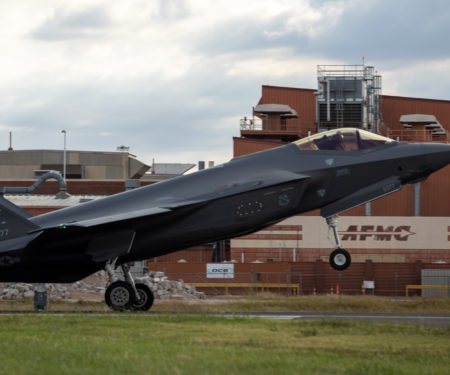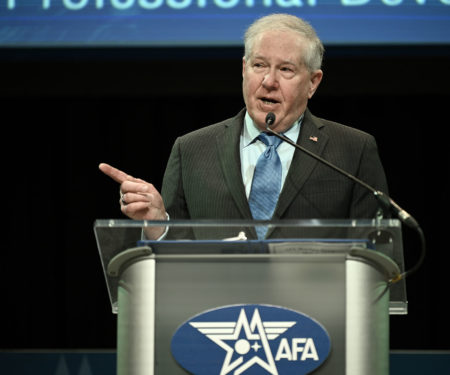Radar Sweep
Senators from Both Parties Press Austin on Sending F-16s to Ukraine
A group of senators from both parties is pressing the Pentagon for more information on what it would take to send F-16 jets to Ukraine. The fresh push came in a letter March 14 to Defense Secretary Lloyd Austin from eight senators, and obtained by POLITICO, as top administration officials from President Joe Biden on down have poured cold water on bipartisan calls to send U.S.-made fighters into the fight for now.
Air Force May Shrink Middle East Presence, Proposed Budget Cut Shows
The Air Force in 2024 hopes to further shrink its presence in the Middle East to focus more resources on countering China in the Indo-Pacific. Service officials on March 14 asked Congress for $7 billion to fund pared-down operations in the Middle East and Southwest Asia as part of the Biden administration’s fiscal 2024 budget request. That’s $1.6 billion less than it received for those missions in 2023.
Lessons Learned from the Defense CIOs’ Recent West Coast Visit to Meet with JWCC Cloud Providers
Chief information officers from each of the U.S. military services traveled to the West Coast in February with Dave McKeown, principal deputy CIO of the Defense Department, to visit the four cloud service providers that were awarded spots on the Pentagon’s Joint Warfighting Cloud Capability (JWCC) procurement.
DOD Acquisition Chief Says New Surge in Munitions Investments Must ‘Stick’ in Future Budgets
Pentagon acquisition chief Bill LaPlante said today he believes the increased U.S. investment in munitions, especially those meant to aid Ukraine and Taiwan, must continue for at least four or five more years. LaPlante, speaking at the Reagan Institute’s National Security Innovation Base Summit, noted the Biden administration’s fiscal year 2024 request for $30.6 billion for missiles and munitions, a 12 percent increase above what Congress enacted in FY23.
Go Deeper on Operational Imperatives
Virtually every part of the Department of the Air Force’s drive to modernize is being shaped by Secretary Frank Kendall’s seven Operational Imperatives—lines of effort that address the most important and urgent challenges facing the Air Force today. Now, the department and industry are working together to develop solutions for each imperative, and the results will likely change the Air Force and Space Force for the next generation. Keep up with all the latest news on each Operational Imperative.
US Gets an ‘F’ for Erratic, Unfocused Funding of Defense Innovation, Says Reagan Foundation
Despite spending over $800 billion a year, the Defense Department chronically under-invests in cutting-edge technology and struggles to leverage the even greater investments being made by private-sector innovators in fields from AI and networks to space and biotech. That’s the verdict of a new report by the Reagan Foundation and Institute, released March 14. But there’s good news: Both in the report and at a conference the foundation hosted, experts from the Pentagon, Capitol Hill, and industry were full of ideas for improvements.
Here's the Pentagon's New Plan to Woo and Retain Cyber Workers
The Pentagon's new strategy lists the many challenges facing the defense cyber workforce, including a labor shortage, which potentially creates a national security risk. However, DOD stresses the importance of having an agile, skilled and diverse workforce to address threats and challenges. “The prior strategy and implementation activities were folded into the broader DOD Cyber Strategy (2015 and 2018),” Navy Cmdr. Jessica McNulty, a Department of Defense Spokesperson, said.
OPINION: Air Force and Space Force on Right Vector—But Need More Resources to Meet Defense Strategy
“Secretary of the Air Force Frank Kendall’s first budget built entirely under his direction does a fine job of underwriting Air Force and Space Force capabilities. But the demands on the Department of the Air Force still far exceed the resources it is allocated,” writes retired Lt. Gen. David A. Deptula, dean of the Mitchell Institute for Aerospace Studies.
Military Leaders Seek Measures to End Food Insecurity Among Service Members
One in four active duty military members have some level of food insecurity according to numbers reported by a recent RAND Corporation study. While it may not be a new problem, senior enlisted military leaders who testified on Capitol Hill last week said economic challenges over the past year have added to food insecurity. Secretary of Defense Lloyd Austin commissioned the RAND study after the fiscal 2020 National Defense Authorization Act directed the secretary to provide a report on food insecurity among members of the armed forces and their dependents.
New US Nuclear Chief Takes Fresh Stance on Sea-Launched Cruise Missile
The new head of U.S. Strategic Command, which oversees the country’s nuclear arsenal, is taking a less forceful tone on developing the sea-launched cruise missile than his predecessor, who was an unabashed champion of the program. Gen. Anthony Cotton neither endorsed nor repudiated the sea-launched cruise missile nuclear program, commonly called SLCM-N, in a February letter to Congress.
As DOD Pivots to Smaller Satellites, Congress Airdrops a Big One into the Budget
The U.S. Defense Department’s head of space acquisitions circulated a memo last fall calling for the Pentagon to embrace a faster, more commercial approach to building satellites. At the top of Frank Calvelli’s “Space Acquisition Tenets” list is to pivot away from billion-dollar behemoths that take a decade to build in favor of smaller spacecraft that can be delivered in under three years. Amid this push for change, Congress enacted a 2023 defense appropriations bill in late December earmarking $442 million for a wideband communications satellite that the Pentagon did not request.
The Icy History of Project Iceworm
Iceworm. The very word conjures all kinds of ideas. A frozen worm? A super-secret lab tucked away into the North Pole? In fact, it was a nuclear lab inside an arctic glacier, and its history is pretty remarkable. In the 1950s, to gain a tactical advantage over the Soviet Union, the U.S. needed to find a location close the European mainland, where it could monitor the Russians. That meant we needed to head for the cold, icy climes of the top of the world. The Pentagon picked Camp Century, Greenland, to construct a top-secret military base for what it had aptly dubbed Project Iceworm.





